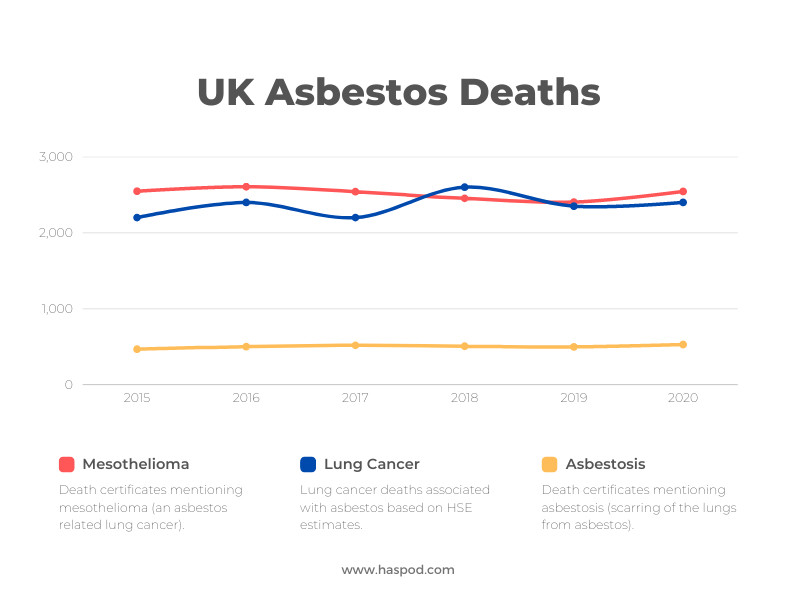26th November, 2024
The Two Types Of Asbestos Survey (And When You Need Them)
There are two types of asbestos survey, the management asbestos survey, and the refurbishment and demolition asbestos survey. A building may require one type, or both, depending on the use of the building and the work planned.

Asbestos is the biggest cause of work-related deaths in the UK. These deaths mostly occur in the construction industry - each week nearly 40 tradesmen on average die from what is known as the 'hidden killer'.
In the UK, around 5,000 people die each year due to past asbestos exposure. And thousands more are diagnosed with fatal asbestos-related diseases.

Because of the high risks that asbestos materials present when found in buildings, asbestos surveys are required by law. There are two types of asbestos surveys:
- Management Asbestos Survey
- Refurbishment and Demolition Asbestos Survey
Why do you need an asbestos survey?
Asbestos was used in UK construction from the early 1900s. It was used extensively in building materials in the 50s, 60s, 70s, and 80s, and wasn't banned in the UK until 1999.

Because asbestos was so popular, any building built or refurbished within that period is likely to contain asbestos.
That's a lot of buildings.
So which buildings contain asbestos, and where can you find it? Well, it's difficult to tell from just looking at a material whether it contains asbestos, and most of the time, the asbestos-containing materials may be hidden beneath other materials.
You can't identify which buildings contain asbestos, just from having a look around.

Asbestos fibres are tiny, they can only be seen under a microscope. That's why we need asbestos surveys. An asbestos survey is the only way to know for certain if you have asbestos.
Asbestos surveys are carried out by an asbestos expert (the asbestos surveyor) to check for asbestos-containing materials. These materials could look like normal plasterboard, insulation, or concrete products, but contain deadly asbestos fibres.
The dutyholder should not appoint or instruct an independent surveyor to carry out a survey unless the surveyor is competent.
Whichever survey you need, it is important that the surveyor you use is competent and has sufficient training, qualifications, knowledge and experience to carry out the survey. The surveyor you choose should have training and experience in all aspects of asbestos survey work, knowledge of asbestos products and an adequate quality management system.
A building may require one type of asbestos survey, the other, or both, depending on what you are doing in the building.
Let's find out about the two types of asbestos surveys, and when you need them.
Management Asbestos Survey
The first and simplest type of asbestos survey is the management asbestos survey.
The management survey is for (as the title suggests) the management of asbestos. Mostly so that building users can be aware of where asbestos is likely to be, and its condition can be monitored so that, for example, if the materials are deteriorating, action can be taken.
A management asbestos survey is usually a visual inspection, noting the condition of asbestos-containing materials, and any risk during normal occupancy.
This type of survey usually involves only minimal sampling and minor intrusive work. The surveyor may presume some materials are asbestos-containing without taking samples.
Management surveys can involve a combination of sampling to confirm asbestos is present or presuming asbestos to be present.
Any non-domestic building built before the year 2000 should have a management asbestos survey in place. That's a legal requirement. Any person with responsibilities regarding the maintenance or repair of non-domestic premises has a duty to manage asbestos under the Control of Asbestos Regulations. The management asbestos survey is part of that duty.

While a management asbestos survey would not usually be required in domestic buildings, it would be needed for any shared parts, such as foyers, corridors and lobbies in a block of flats, for example. Therefore many buildings with public access or tenanted properties will have a management survey in place (previously known as a type 2 survey).
The management survey gives you the information needed to manage and monitor asbestos-containing materials. This will include preparing an asbestos register and developing an asbestos management plan.
Providing materials remain in good condition they do not pose a threat during normal occupancy, as providing asbestos is not disturbed, it does not harm you.
However, this type of survey is not suitable for construction or refurbishment work, or extensive maintenance work.
When do you need a management asbestos survey?
You need a management asbestos survey during the normal occupation of a building.
This is required on any non-domestic buildings or shared parts of domestic buildings built pre-2000. It is worth mentioning here that private residential properties may also contain asbestos, but are not required to have an asbestos management survey in place.
Refurbishment and Demolition Asbestos Survey
Asbestos-containing materials are most likely to be disturbed during construction work. And that's when asbestos becomes dangerous. Once materials are disturbed and the tiny asbestos fibres are released, they can be breathed in by those close by.
When asbestos fibres enter your lungs, you are at risk of developing fatal asbestos-related diseases.

How do you know if you have breathed asbestos? Unless you identify the asbestos-containing material - you won’t.
There are no immediate effects.
However, what doesn't hurt you now may kill you in 20 years.
A refurbishment and demolition survey (previously known as a type 3 survey) is needed when materials are being disturbed as part of a refurbishment or demolition project, or other types of construction work.
Whenever construction work is being planned, a refurbishment and demolition survey should be carried out. This includes refurbishment, maintenance work that disturbs existing building materials, demolition, extensions and other construction activities.

Unlike the management survey, the refurbishment and demolition survey is a far more detailed survey.
This type of survey is fully intrusive, and the building or areas being surveyed will usually need to be vacated so that extensive samples can be taken. Samples of building materials will be taken to determine the type, location and extent of all asbestos materials, including those hidden within the building structure, for example behind other materials.
An employer must not undertake work in demolition, maintenance or any other work which exposes or is liable to expose employees of that employer to asbestos in respect of any premises unless...
- that employer has carried out a suitable and sufficient assessment as to whether asbestos, what type of asbestos, contained in what material and in what condition is present or is liable to be present.
The survey should cover the area or materials that will be disturbed. You do not need to survey the entire building if work is only taking place in one room.
Any suspected materials will be sampled and tested in a laboratory. The results let contractors know what they will be dealing with, so they can take the right precautions. The asbestos survey will contain information on the type of asbestos identified so that you can make arrangements to remove it if necessary.
Some types of asbestos materials are licensed. This means that only licensed contractors can carry out work on the material. A licensed contractor will notify the HSE, and remove the asbestos under controlled conditions.
All asbestos waste is hazardous and requires careful removal and waste transfer to a licensed site.

When do you need a refurbishment and demolition asbestos survey?
You need a refurbishment and demolition asbestos survey before carrying out construction work.
This type of survey must be carried out on any building built before 2000, unless you know for certain there is no asbestos present (due to prior removal or other evidence). This applies to any type of building, including residential.
A refurbishment and demolition survey is needed before any refurbishment or demolition work is carried out. This type of survey is used to locate and describe, as far as reasonably practicable, all ACMs in the area where the refurbishment work will take place or in the whole building if demolition is planned.
Whether you require the management asbestos survey, or the refurbishment and demolition asbestos survey, your survey must be carried out following recommended guidance, by a competent asbestos surveyor.
Download the free asbestos surveys toolbox talk as a reminder of the two types of asbestos survey, and when you need them.
This article was written by Emma at HASpod. Emma has over 10 years experience in health and safety and BSc (Hons) Construction Management. She is NEBOSH qualified and Tech IOSH.
Are You Asbestos Aware?
Take our asbestos awareness elearning course and get your certificate today.
Asbestos Awareness CourseRecent posts like this...

10 Asbestos Awareness Questions And Answers Explained
If you have had, or are about to refresh, your asbestos awareness training, you should be able to answer these 10 asbestos awareness questions. Don't worry if you are not sure about the answers - we explain them in this post to help prepare you for your asbestos awareness training.
Read Post
The Risk Of Asbestos In Artex Ceilings
Many buildings contain artex and other textured coatings on walls and ceilings that may contain asbestos. The biggest risk is not the artex itself, but the potentially deadly fibres contained in it. In this post, we look at when you should be worried, and what the law says about asbestos in artex.
Read Post
The Two Types Of Asbestos Survey (And When You Need Them)
There are two types of asbestos survey, the management asbestos survey, and the refurbishment and demolition asbestos survey. A building may require one type, or both, depending on the use of the building and the work planned.
Read Post